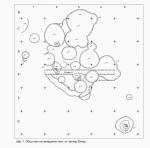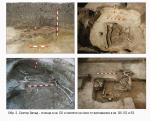Summary (English)
ARCHAEOLOGICAL EXPLORATIONS NEAR THE VILLAGE OF BENKOVSKI (Iliana Borisova – ilianabo@yahoo.com) Over 25 ritual pits, most of them overlapping, were explored in Sector West over an area of c. 500 sq. m. Three pits in trenches Е2/D2, Е3 and G5 contained one sacrificed horse each. The pit in trench E2/D2 contained a sacrificed horse oriented southeast – northwest. The pit in trench E3 contained a sacrificed horse oriented southeast – northwest. It was a saddle-horse decapitated with a single hit upwards in the neck. The skull of the horse was missing. The finds included Thracian sherds, burned fragmentary wattle-and-daub, bones from other animals and small pieces of charcoal. The sacrificed horse in the pit in trench G5 was a mare, 8 – 10 years old. The finds included fragmentary Thracian ceramic vessels, burned fragmentary wattle-and-daub and bones from ox and sheep or goat. The rest of the ritual pits had oval layouts, 1 – 2.40 m in diameter, and contained sherds, burned fragmentary wattle-and-daub and animal bones. A pit in trench C1 contained a lower jaw of a horse. The archaeobotanical analysis showed the presence of Triticum monococcum and oak. The oval pit, documented in 2008 and c. 5 m in diameter, was explored in Sector East. It contained Thracian sherds, charcoal, fragmentary wattle-and-daub and a spindle whorl. The finds from the excavations included Thracian pottery, including sherds from the Tsepina Group, fragments from terracotta escharai with imprinted cord decoration, two bronze coins of Maroneia dated to the first half of the 4th century BC, a terracotta dice and a flint flake, probably from a sickle. The Thracian ritual complex dated to the 4th – 2nd centuries BC.
- Iliana Borisova - Department of Archaeology, Sofia University St. Kliment Ohridski
Director
Team
Research Body
- Sofia University St. Kliment Ohridski






![Download [PDF]](/excavation/skins/fasti/images/results/download_sml.png)
